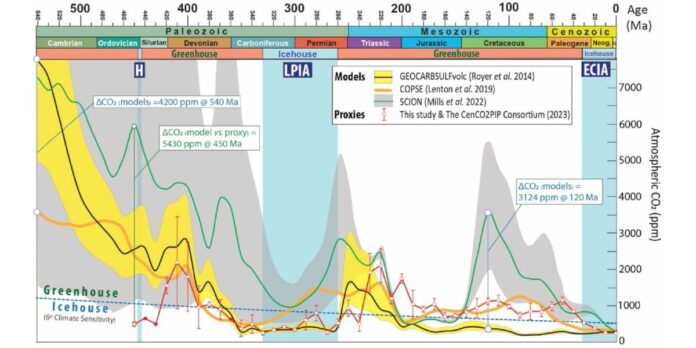Essay by Eric Worrall
Apparently our pitiful atmospheric contribution is comparable to the 2 million year eruption which drove the Permian–Triassic Extinction, which wiped out most life on Earth.
‘A climate of unparalleled malevolence’: are we on our way to the sixth major mass extinction?
Churning quantities of carbon dioxide into the atmosphere at the rate we are going could lead the planet to another Great Dying
By Peter Brannen
Tue 19 Aug 2025 14.01 AESTLast modified on Tue 19 Aug 2025 14.20 AEST…
Put enough CO2 into the system all at once, and push the life-sustaining carbon cycle far enough out of equilibrium, and it might escape into a sort of planetary failure mode, where processes intrinsic to the Earth itself take over, acting as positive feedback to release dramatically more carbon into the system. This subsequent release of carbon would send the planet off on a devastating 100-millennia excursion before regaining its composure. And it wouldn’t matter if CO2 were higher or lower than it is today, or whether the Earth was warmer or cooler as a result. It’s the rate of change in CO2 that gets you to Armageddon.
…
Here’s a plausible sequence of events at the end of the Permian. First, and most simply: the excess CO2 trapped more energy from the sun on the surface of our planet – a simple physical process that was worked out by physicists more than 150 years ago. And so the world helplessly warmed – models and proxies both point to about 10C of warming over thousands of years – pushing animal and plant physiology alike to their limits. It’s also a simple physical fact about our world that for every degree it warms, the atmosphere can hold about 7% more water, so, as the temperature climbed and the water cycle accelerated, storms began to take on a menacing, drowning intensity. As the ocean warms as well, it holds less oxygen.
…
Now let’s pull back from the brink. However similar to this era our modern experiment on the planet might first appear, it’s worth acknowledging, even stressing, that the end-Permian climate catastrophe was truly, surpassingly bad. And on a scale unlikely ever to be matched by humans. Upper estimates for how much carbon dioxide the fossil-fuel-burning Siberian Traps erupted, ranging up to 120,000 gigatons, defy belief. Even lower estimates, of say 30,000 gigatons, constitute volumes of CO2 so completely ridiculous that matching it would require humans to not only burn all the fossil fuel reserves in the world, but then keep putting ever more carbon into the atmosphere for thousands of years. Perhaps by burning limestone for fun on an industrial scale for generations, even as the biosphere disintegrates. As it is, industrial civilisation could theoretically generate about 18,000 gigatons of CO2 if the entire world pulled together on a nihilistic, multicentennial, international effort to burn all the accessible fossil fuels on Earth.
…
Back in the real world, the Earth is still locked in a brutal Late Cenozoic Ice Age ice age, which started 34 million years ago, yet still threatens to crush our civilisation under mile high walls of ice – so we have plenty of buffer between us and any kind of geologically significant global warming event.
Life has thrived under far higher CO2 levels than today. The graphic at the top of this page came from User-friendly carbon-cycle modelling and aspects of Phanerozoic climate change. During the late Carboniferous for example, CO2 levels were likely far higher than today, but despite elevated CO2 the Earth still experienced icehouse conditions, similar to today’s ice age cycle. So clearly CO2 isn’t the only factor driving climatic conditions.
The ice age of the last 34 million years is a lot of ice age. Clearly something more powerful than CO2 is keeping our planet locked in the ice box. It is likely industrial CO2 emissions will fail to overcome today’s geological ice box forcings, just as much higher CO2 levels failed to overcome the powerful geological ice box forcings which created the Late Paleozoic icehouse during the Carboniferous.
Even if I’m wrong, and substantial warming does occur, we have strong evidence humans would thrive in such conditions. Our monkey ancestors made their debut in the fossil record during much warmer conditions than today. The Palaeocene-Eocene Thermal Maximum, 5-8C hotter than today, was the age of monkeys. Our monkey ancestors thrived on the abundance of the hothouse PETM, and colonised much of the world, only retreating when the cold returned. If a bunch of monkey ancestors with brains the size of matchboxes could thrive in a much world, then we humans certainly could – which gives us at least a 5-8C buffer of safety against any imaginable global warming event.
Fish also did well during the PETM – so it’s not just humans who would thrive in such warm conditions.
Given the remarkable stability of the Earth’s climate on geological timescales, the fact the Earth is still locked in an ice age, the benign conditions which prevailed in previous much warmer ages, and the existence of previous ice age epochs with far higher CO2 levels than today, those who focus on the carbon cycle alone are overlooking some pretty important evidence. Given all this, I believe we can reasonably conclude claims that industrial emissions are creating a man made Permian Extinction are an absurd fantasy.
Related
Discover more from Watts Up With That?
Subscribe to get the latest posts sent to your email.



